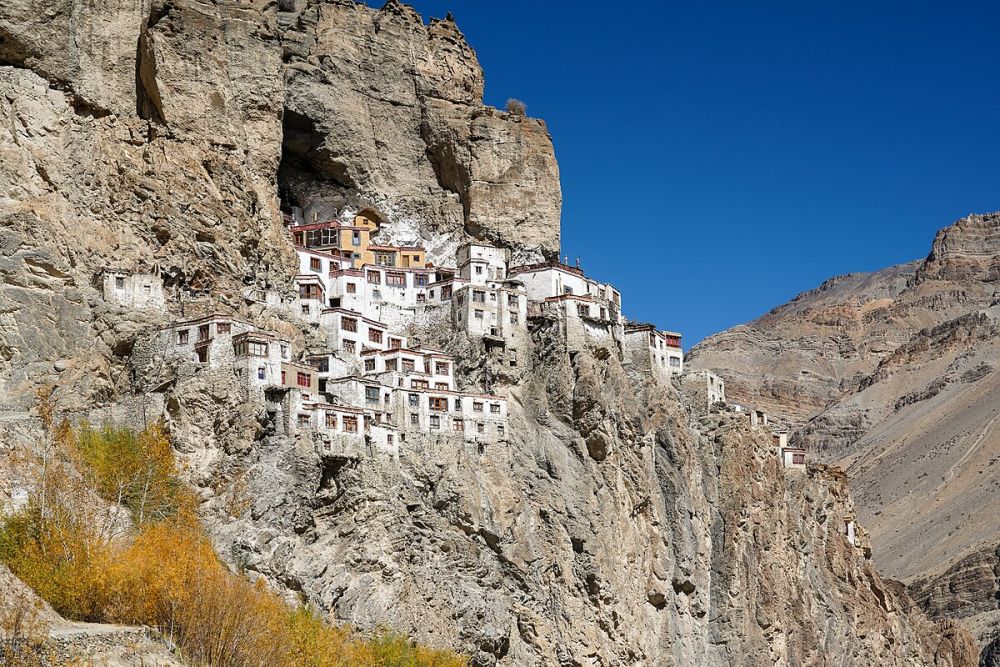

The Phuktal Monastery, also spelled Phugtal, is a Buddhist monastic complex tucked into the cliffside of a remote valley in the southeastern part of Zanskar, in the autonomous Himalayan region of Ladakh, India. With its roots stretching back to the early 12th century, Phuktal Monastery is a testament to human devotion and architectural ingenuity.
The foundation of Phuktal Monastery can be traced back to the 12th century when Gangsem Sherap Sampo, a disciple of Gelug founder Tsongkhapa, established the monastery. The site has long been a place of retreat, meditation, learning, and teaching. It is said that the renowned scholars and brothers Dangsong, Pun, and Sum, who were the main disciples of the great translator Rinchen Zangpo, had visited the cave in the 11th century, making it a place of holy pilgrimage. The monastery, built like a honeycomb into a cliffside, is accessible only by foot, which adds to its allure and mysticism. Historically, it has been a destination for Buddhist scholars and a bastion of Tibetan culture.
Tourism in Phuktal Monastery has never followed the conventional path due to its remoteness and challenging accessibility. Until the late 20th century, it received only the most intrepid of travelers and devout pilgrims. The last few decades have seen a gradual increase in visitors, drawn by the spiritual, cultural, and adventurous appeal of the region. With the development of the tourism infrastructure in Ladakh, more tourists have begun venturing into Zanskar, intrigued by its pristine nature and unique monastic traditions.
Ladakh has recently seen a surge in popularity amongst tourists seeking off-the-beaten-path destinations. Trekking is a major draw, with the Phuktal Monastery often being a highlight of such multi-day treks. Occasionally, homestays and guesthouse options have emerged within the Zanskar region, permitting tourists to experience local lifestyles. Adventure tourism, such as river rafting and high-altitude cycling, has also gained traction.
Responsible and sustainable tourism practices are increasingly promoted, recognizing the fragile ecosystem of the region. Initiatives focusing on eco-friendly accommodations and protection of cultural heritage are growing. Tourism now provides an essential source of income for many local inhabitants while fostering cross-cultural exchanges. Amidst this, Phuktal Monastery stands as a remarkable beacon of spiritual heritage and human resilience.
Visitors to Phuktal Monastery can engage in meditation, attend prayer ceremonies, and explore the monastic complex, including its ancient library and vibrant murals. It is also a unique place to learn about the ways of life of the monks who reside in this distant hub of Buddhism. The journey to Phuktal itself is an adventure, taking travelers through some of the most untouched and stunning landscapes of the Indian Himalayas.
Travelers wishing to embark on this journey must prepare themselves for rugged terrain and high altitudes, and it is recommended to arrange trips through experienced local guides and travel agencies. The best time to visit is between June to September, when the paths are most accessible. Whenever you choose to go, Phuktal Monastery promises a deeply meaningful and unforgettable experience.
In conclusion, Phuktal Monastery continues to be not only a place of spiritual practice but also a cherished destination for those in quest of peace, beauty, and adventure. Its increasing popularity in the realm of tourism is a testimony to its timeless appeal and the enduring legacy of Buddhism in the Indian Himalayas.
Note: Given the remote location of Phuktal Monastery, it is essential for visitors to respect the local customs and environmental integrity to help preserve this precious site for future generations.